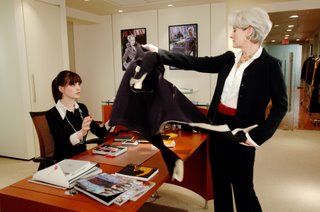
Ignore the poster, which looks like lesbian gymnastics performed atop a skull-shaped volcano. [It's below, for posterity.] And forget, for the moment, that its writer-director has modified its ending for its US release, which begins August 4 via Lionsgate. From web forums to the pages of Film Comment magazine, The Descent has been proclaimed as the scariest horror film to come down the pike in some time, and I'm not going to argue with that. I'm at an age where an increased lipid count or a decreasing bank balance upset me more than some movie boogeyman, and I rarely emerge from a horror film shaken anymore. [The true-life terror of United 93, or the paranoia-wracked atmosphere of A Scanner Darkly, still get under my skin.] Mileage will certainly vary as how alarming The Descent is. My guess is, given the basic, unnerving situation--female spelunkers, at odds with one another, versus unrelentingly vile humanoid "crawlers" in the claustrophobia of an unmapped cave--it will be a very intense hour-and-45-minutes for many. Scares aside, however, I admired the craft behind the film, which marks its British auteur, Neil Marshall, as a true classicist in a genre frequently given over to the jokiest, crassest exploitation.
Foreign-made horrors have a tough time on these shores. With the best intentions for the US audience, Lionsgate did more harm than good to the French-made Haute Tension, dubbing (ugh!) a movie that had more screams than chat-chat and cutting it back for an R-rating. The original edit is available on DVD, but the damage had been done. Marshall's first horror film, 2002's Dog Soldiers, premiered, between commercial breaks, on the Sci-Fi Channel, hardly an optimum venue. Amidst the ads, however, it was clear that Marshall was a cut above--the humdrum scenario, male military types going mano-a-paw with werewolves, was invigorated by reasonably somber telling and well-handled setpieces. The Descent continues in this vein, paring away the CGI, obvious scares, faux politicizing (as in the exploitative Hostel) and juvenile humor (a pox since the sequelizing of Freddy Krueger) that have settled like tumors on the form, and exposing the vital nerve endings.
Why does The Descent work as well as it does? For starters, it keeps the plot simple, and visual; action reveals character, and the emotions deepen without a lot of useless expository dialogue, as in The Texas Chain Saw Massacre, one movie that did work me over. The movie opens with a real jolt: The car accident deaths of the husband and daughter of Sarah (Shauna Macdonald, pictured above), following Sarah's annual extreme sports jaunts with her friends (in a reverse on Dog Soldiers, The Descent's leads are all female). A year later, Sarah, feeling nominally better but still haunted by visions of her dead child, agrees to join her gal pals on their latest adventure, exploring caverns. The group leader is Juno (Natalie Mendoza), Sarah's best friend--but, if you were paying attention to the first scene, it's clear that the friendship had ruptured, likely over infidelity on Juno's part with Sarah's husband. It's easy to miss this, as we're used to being spoon-fed rationales and explanations for behavior, but Marshall, in the tradition of the suggestive scenarios of Rosemary's Baby and Val Lewton (producer of the classic RKO chillers of the 40s, like Cat People and I Walked With a Zombie), doesn't dumb us down.

Within the caves (a beautiful series of sets designed by Simon Bowles, and imaginatively shot by Sam McCurdy), emotional fault lines develop. The movie is reminiscent of Deliverance in this regard but Marshall, to his credit, doesn't wear hommages on his sleeve. The bickering and in-fighting that develop leave the women (including Rebecca, played by Saskia Mulder, and Sam, played by MyAnna Buring, pictured) that much more defenseless when the monsters show up. Here again the movie is commendable, in that the creatures have been rendered prosthetically (by Paul Hyett), and not digitally, and move, and strike, credibly, rather than fantastically. Supported by an eerie soundscape that vibrates and hisses, you buy into the illusion. [Peter Jackson is one of the few filmmakers working in the CGI realm whose creations behave with some passing nod to the real world; see, or, rather, pass on seeing Van Helsing for the opposite.] In and of themselves, monsters aren't necessarily frightening; it's the buildup that gets you, and sustains you through the next twists in the storyline, and so it is with The Descent, in the tradition of Jawsand the very best creature features. Things get messy as the movie turns the screws, quite logically I found, but Marshall doesn't try to terrorize us with gore effects, which usually expose the limitations of the makeup artists (one exception is a horrific stalking sequence in the 1979 Zombie, a knockoff of Dawn of the Dead, but there, too, the mod is set up creaky, bump-in-the-night audio effects).

As it happens, I like the way The Descent ends. Lionsgate and Marshall need not apologize for trying it out here in the US. I don't think it's a cop-out, and not seeing it because it has an alternate conclusion is a clear instance of cutting off your nose to spite your face. The original ending may be more elegant, and more disturbingly symmetrical, but if the new one is a compromise at least it's a creative one. And it doesn't lead to speculation that all of this is happening in Sarah's tormented mind, which I don't buy. Marshall has made an excellent monster movie--if he believes in the existence of his monsters, so should we all.
[But, if you have to scratch that itch, the original ending is on the Region 2 DVD, which has made it toYouTube. Don't click till you've seen the film proper. It's worth seeing in the darkest recesses of your local bijou.]
Photos by Alex Bailey.
[By the way, this entry should push me above the 2,000-hit mark. Thanks for reading, and feel free to chime in.]














